|
|
The village of Utoropy lies between the towns of Kolomyia, an ancient trading town, and Kosiv which prides itself on being the gateway into the Carpathian Mountains. Last July we spent several days in Utoropy as we traveled through the villages of Ukraine collecting material for a new show we would create with Yara Arts Group.
The artistic team on our expedition was composed of: Maryana Sadovska, an actress who collected folk songs, Yaryna Turianska, an ethnomusicologist, myself and Andrea Odezhynska, a film and video director from New York. We picked Andrea up at the airport in Kyiv and drove straight to catch the all night train to Ivano-Frankivsk. On the train we had a little party. It was Andrea's birthday. We sang "Happy Birthday," Andrea blew out the candles on the cake Yaryna baked and we talked late into the night.
From Ivano-Frankivsk we drove to Utoropy with Dmytro Kuryshchuk, who wanted to introduce us to his native village. A proud son of Utoropy, Mr. Kurushchuk was first and foremost a journalist, so our first activity in the area was an interview with the local paper "Hutsulsky kray" (Hutsul land) in Kosiv. The interview was conducted over lunch where we first tasted "banosh." This local delicacy, made of cornmeal that is cooked on fresh cream, is nothing short of heavenly. Oh, what wouldn't we do for a plate of authentic homemade "banosh."
 Dmytro Kuryshchuk, Yaryna Turianska, Virlana Tkacz,
Andrea Odezynska, reporter from "Hutsulsky kray" newspaper and Maryana Sadovska
Dmytro Kuryshchuk, Yaryna Turianska, Virlana Tkacz,
Andrea Odezynska, reporter from "Hutsulsky kray" newspaper and Maryana Sadovska
After our interview, we returned to Utoropy to the local school where we were to meet our host family. The school walls were lined with children's art projects. There were displays dedicated to fairy tales, space and various holidays, as well as fantastically shaped natural wood piece the children had found. A special exhibit was dedicated to "Smerichka," the school's renowned folk ensemble, which was celebrating its 40th anniversary. I was particularly taken with one of the art projects. A child had cut a village house and various characters out of a single piece of sheet metal. The characters included: a soldier and death, a bride and groom, a couple of gypsies, an old man and a baba. The devil sat on the roof next to the moon. I assumed these were the worldly characters from the Christmas vertep. Later I learned that these were the characters of a more ancient tradition from this area called Malanka. It was a pleasure to look at all the children's work displayed at the school. Obviously, a lot of love and care held this school together, because there were also signs that the school could use some serious financial support.
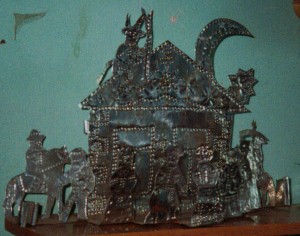 Malanka at the Utoropy school
Malanka at the Utoropy school
We were delighted to learn that our host for the next three days was to be Maria Lasiychuk, the director of the school. We drove to her home up the hill and off to the main road. Past the second stream that tricked across the dirt road we saw an orchard, a prancing horse, drying haystacks and a well-kept home. Mrs. Lasiychuk introduced us to her family: her husband Petro, daughter Oksana and son Ihor. She informed us that she had arranged a busy schedule for us. As an introduction to the area, that evening we were to meet the village elders who knew the oldest songs and tales.
We drove to a part of the village the locals call the "Bania." This is where natural brine bubbles up in Utoropy. For centuries it was boiled in the "banias" till the water evaporated and the salt could be gathered. The salt industry was one of the oldest industries in Ukraine and for a long time it was one of the most important one. It first emerged in this area, which for centuries was the main salt-producing region of medieval Ukraine. Today there are few traces of the famous Utoropy salt industry. The salt works had brought great riches to the various magnates and officials involved in the trade, but the Austrian government had a monopoly on salt. It closed the works in Utoropy in 1786 and they never reopened. However, to this day village people boil the local brine to get salt for home use. We each were given a cup of salt as a memento from Utoropy.
We pulled up to the Bilenchuk home and started to haul out our bags from the car and assemble our recording equipment. There was a significant amount of it, but soon we were ready for the village elders who were gathering outside. Maryana talked with some of the older women, while I watched a master craftsman build a little wooden chapel and cover it with decorated sheet metal. We had seen a number of similar chapels along the roads here. Dmytro Boldash said he had built many of them. When I asked why they were constructed. He told me that in these parts a family often would turn to God in hard times and then they would promise to have a chapel constructed if their prayers were answered. One could say that all the chapels we had seen were answered prayers.
Meanwhile, Yaryna found an old friend. Dmytro Pavliuk was a musician, she had met on her trip to this village five years ago. She was very saddened to hear that Dmytro's father, a flute player known as "Nikolus," had passed away. We walked up the hill to the cemetery with his son and paid tribute to this legendary musician.
The sun was setting as we headed back. It painted the surrounding rolling hills a luscious golden purple. We passed a larger chapel and some ruins that I later learned were the remains of the old church in Utoropy, which was struck by lightening in 1899. The wooden church burned to the ground in the fire that destroyed a treasure trove of ancient church books, parish records and icons. The single surviving icon, which depicts St. Michael, gives us an idea of the beauty of the works that were lost in the fire. A new church was completed further down the hill in 1929.
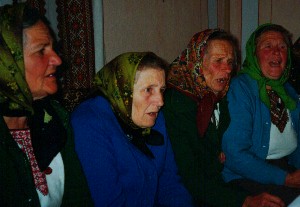 "Vechenytsi" in Utoropy
"Vechenytsi" in Utoropy
We stepped into the Bilenchuk home and were treated to an evening of song and stories, real "vechernytsi, like we hadn't had in a long time" according to the one of the Utoropy elders who attended. The lead singer was Nastya Sabadash, a thin energetic woman who didn't look her age. She knew the oldest songs and had a great sense of humor. Her sister Hanna Voloshchuk sang with her and composed several of the new songs we heard that evening. Especially, moving was her song about Vyacheslav Chornovil, a Ukrainian dissident and politician who had recently died in a car accident. There were several musicians including a man who played a "telynka," a flute without finger holes.
Since we plan to do our show in the winter, we asked the group to sing us some Christmas carols. The group obliged
us with some wonderful old songs with magical tales had little to do with the usual Christmas story. The carolers included
several children who couldn't stop giggling at the idea Christmas carols in July. But they were delighted to find that were
treated as well as more seasonal carolers. Each received a big bar of chocolate before being sent to bed. The elders and
adults continued to sing long into night.
 Natsya Sabadash and her sister Hanna Voloshchuk
Natsya Sabadash and her sister Hanna Voloshchuk
Although we were up late recording the singers, Mrs. Lasiychuk got us up early next morning. She didn't want us to miss any part of the preparations for the wedding that day. A traditional village wedding is a major event that even in its abbreviated contemporary form takes several days. We had already missed the baking of the "korovai" (wedding cake) and the decoration of the "viltse" (wedding tree) by the bridesmaids the previous days. We had to catch the arrival of the musicians at the house. We rushed through a dinner-sized breakfast, checked our equipment and headed out.
The wedding took place at the homestead of the groom, located on a hill accessible only by foot. We walked past drying haystacks that changed color with every passing morning moment. Looking at the light play on the haystacks I thought: "How static by comparison is the light caught on those great Impressionist canvases." We lugged our equipment through a cornfield, past the beanstalks and over a stream. Behind a row of poplars we saw a huge army tent with a great wooden floor. It was decorated to the hilt with branches, balloons and streamers. This would alternately serve as the banquet hall and dance floor for the night's festivities.
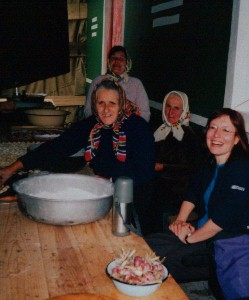 Making varenyky and talking about America in Utoropy
Making varenyky and talking about America in Utoropy
There were several smaller tents and shelters set up throughout the yard. In one, a group of neighborhood women were making the "varenyky" and "pelmeni" for the feast. I decided to join them. The best discussions always happen over this kind of work. I asked the women about the wedding rituals and customs. In turn, they asked me a lot of questions about our lives in America. They were particularly interested in how Andrea and I learned to speak Ukrainian. Apparently, the few people they had come to their village from America were either old, or couldn't really speak Ukrainian. I told them about our Ridna Shkola, the Ukrainian Saturday School I attended for twelve years in Newark, as well as the various other Ukrainian activities, such as dancing, embroidery and scouting, that we were all involved in when I was a child. Soon Andrea joined us as the table and told her own stories about her Ukrainian school in Philadelphia and her experiences dancing with the renowned "Voloshky" Dance Troupe.
Then the musicians arrived. The group included Dmytro Pavliuk, the flutist we had met the previous day and Yaroslav Yakovenkchuk who played the saxophone and the accordion. There was also a young key-broad player and a drummer who could play the accordion, bass guitar and really "call" a great "Holubka," a traditional dance that proved the highlight of the party that night. Normally, this group also included a fiddler, but he could not be with them that day.
The musicians gathered at the door of the room where the bride was dressing. They started playing and the parents came out to greet them. "Pan Gazda" treated each to a hefty shot and the music started. The musicians were a hearty lot; they would constantly play till the next morning taking very few breaks.
Music was an essential to every part wedding ritual. A group of elder women sang the traditional wedding songs that accompanied every moment of the preparation. There were songs for the moment when the veil was put on the korovai (wedding bread), when the veil was attached to the bride's headdress and when the bride parted with her mother.
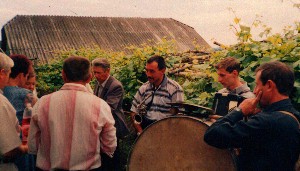 The musicians arrive
The musicians arrive
Every village has its own wedding songs. We had first heard wedding songs in Kryachkivka in Poltava region. The women sang the wedding songs so we could record them and in between takes quickly related the events that took place with each song. The songs were beautiful and I loved them, but I didn't really grasp their significance. In Utoropy I for the first time saw the events with the songs. I started to realize that the songs were not merely pretty accompaniment, but were actually instructions on how each moment of the ritual was to be performed. A ritual must be performed correctly to have the desired result. The songs helped the participants remember the correct actions.
The groom, Ivan, was a local Utoropy boy who worked in Eastern Ukraine, where he met his bride, Svitlana who was from Mykolaiv. Svitlana was a pretty blond and the big hoop white wedding dress she chose underlined her resemblance to Barbie. She did not speak Ukrainian well, and neither did the family members who had come with her to the wedding. Their idea of wedding traditions included champagne, two crystal glasses for the couple and a beautiful, but store-bought, korovai (wedding bread) shaped like a wreath. Svitlana's mother had proudly showed me all these items which she had brought with her from Mykolaiv. But a wedding in Pokuttia today retains many of the elements of traditional weddings from days gone by. Svitlana's family members proved surprisingly willing participants in the complex local wedding traditions. However, they didn't know the correct pattern of action. Local people would often have to run up to them and whisper instructions. At other times, they would get their clues from the songs.
After the rituals in the bride's room everyone involved in the wedding gathered and followed the "viltse", (wedding tree) to the church. The procession, including the wedding couple, the wedding party, family and friends, walked several miles through fields and yards then down a muddy road to church. They were accompanied every step of the way by the lively sounds of the wedding band. Neighbors peeked out their windows and ran to look over the fences to see the happy procession.
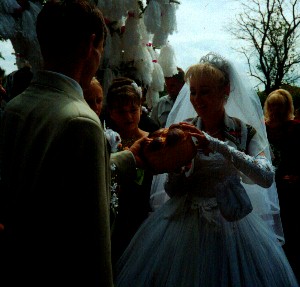 Ivan and Svitlana pull apart the "korovai" to see who will have the upper hand
Ivan and Svitlana pull apart the "korovai" to see who will have the upper hand
The ceremony was at St Michael's. Afterwards there was one more wedding ritual outside. The bride and groom were given a "korovai" and told to pull it apart. Who got the larger piece, would be the dominant one in the relationship. It seemed to me that Svitlana pulled in such a way to let Ivan get the larger piece. The young couple posed for pictures under the "viltse" and then drove off for official pictures. The rest of the wedding procession followed the "viltse" back to the homestead.
We walked down the hill with them, the group stopped at a little cross near the road and left flowers. I walked up afterwards to see what the monument commemorated. It was erected in 1848 and was a prayer of thanks to God for seeing the day when serfdom was finally abolished. I would see these type of crosses in many of the other villages we visited.
Since we had stayed up late the previous night, we decided to nap before heading out to the wedding party. The nap turned into some solid sleep. It was after midnight when Andrea woke Yaryna and Maryana and convinced them that she just had to get some video of the dancing. They walked with her in the pitch black of the night to the wedding party. I woke up a few hours later to find the room empty and figured the girls couldn't resist some wedding dancing. I grabbed my camera and headed out after them.
I came for the highlight - the "Holubka," a pairs dance, during which one of the musicians called out various tasks for the couples to perform. The musician was very witty so the dance was great fun. I shot the members of our team really enjoying themselves. They ran over to me afterwards to tell me of the "Hutsulka," a very fast traditional dance, which I had just missed. Apparently, the dance was announced as a special for the "American." One of the guys who was a great dancer invited Andrea to dance. He figured he could show her a thing or two about Ukrainian dancing and would exhaust her in a few minutes. What the poor "Hutsul" didn't know was that Andrea had eight years of experience with the great Voloshky Dance Troupe of Philadelphia. Soon he was begging her "don't spin me so hard, I'm just a little guy." His friends and neighbors found this all hilarious.
The music paused at dawn for another traditional ritual. The bride's veil was cut off and she put a white kerchief on her head. Then she danced with all the unmarried women in tent, holding her veil over their heads. Meanwhile the groom danced with all the young males.
 The bride and wedding party dance around the "viltse" in the tree
The bride and wedding party dance around the "viltse" in the tree
Then the "viltse" was brought out into the yard and fastened to the top a tree which gave the most fruit. An old man started running desperately around the yard trying to gather the young folk to dance around the "viltse" in the apple tree. He kept yelling "a teper musete tantsiuvaty," (now you must dance ). The ritual must be done correctly to have the desired effect. A ritual that is not completed properly can have dire consequences. His desperate attempts soon had results. A ring of young people, as well as the bride and groom and their parents, started dancing around the tree. They stomped through the mud in their high heels, dance shoes and sneakers, wishing the new couple a fruitful marriage as the sun rose in the pale morning sky.
Then the tables were set again on what had just been the dance floor. We were more exhausted than hungry and were about to escape when they brought out the "banosh." All four of us sat right back down, spoon in hand, and launched into our favorite little bit of heaven.
Virlana Tkacz is the artistic director of Yara Arts Group, which is currently working on a new show, "Song Tree," based on traditional songs the group recorded in the villages of Ukraine. It will be shown at La MaMa Experimental Theatre in New York in December.
This article is forthcoming in the November issue of Our Life.
photos by Andrea Odezynska, Virlana Tkacz and Yaryna Turianska.
BRAMA, Inc.
Copyright (c)1995-2000 Yara Arts Group; all rights reserved. Photos by Virlana Tkacz
|
 UTOROPY: A VILLAGE WITH SALT IN ITS HISTORY
UTOROPY: A VILLAGE WITH SALT IN ITS HISTORY